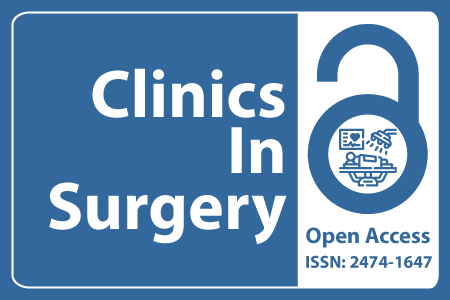
Journal Basic Info
- Impact Factor: 1.995**
- H-Index: 8
- ISSN: 2474-1647
- DOI: 10.25107/2474-1647
Major Scope
- Thoracic Surgery
- General Surgery
- Bariatric Surgery
- Otolaryngology - Head and Neck Surgery
- Gastroenterological Surgery
- Pediatric Surgery
- Surgical Oncology
- Colon and Rectal Surgery
Abstract
Citation: Clin Surg. 2021;7(1):3379.Research Article | Open Access
Protein Identification and Haplotype Description of Homozygote Mutation Causing Congenital Plasminogen Deficiency
Raquel Rodríguez-López1*, Fátima Gimeno-Ferrer1, Altea Esteve Martínez2, Andrés Casanova- Esquembre2, Jorge Magdaleno-Tapial2, Carola Guzmán Luján1, Armando Mena Durán3, María Dolores De Las Marinas Álvarez4, Laura Hernandez-Bel5, Pablo Hernandez-Bel2 and Manuel M Sanchez Del Pino6,7
1Genetics Laboratory, Clinical Analysis Service, Spain
2Dermatology Service, General University Hospital Consortium of Valencia, Spain
3Hematology Service, General University Hospital Consortium of Valencia, Spain
4Allergololly Service, General University Hospital Consortium of Valencia, Spain
5Ophthalmology Service, General University Hospital Consortium of Valencia, Spain
6Proteomics Unit, Central Service for Experimental Research (SCSIE), University of Valencia, Spain
7Department of Biochemistry and Molecular Biology, University Institute of Biotechnology and Biomedicine (BIOTECMED), University of Valencia; ProteoRed (Proteomics and membrane proteins), Spain
*Correspondance to: Raquel Rodríguez-López
PDF Full Text DOI: 10.25107/2474-1647.3379
Abstract
Severe type I Plasminogen (PLG) deficiency was clinically diagnosed after hyaline-positive periodic acid Schiff material was detected in the histologic study of superior tarsal conjunctiva and vulvar pseudomembrane of the patient. Direct immunofluorescence also confirmed multiple deposits of fibrinogen in the dermis. Plasma plasminogen activity was calculated in a <5% value (reference values, 75% to 150%) and sequencing of the PLG gene evidenced the homozygous mutation in c.2377T/A (p.Tyr793Asn), confirming the molecular diagnosis of congenital deficiency of plasminogen type 1. Genotype-Phenotype correlation among family members evidenced the recessive hereditary pattern of clinical manifestations of chronic inflammatory disease of the mucous membranes due to PLG deficiency, but co-dominance effect to present a decreased plasma plasminogen activity (46%) among heterozygous asymptomatic individuals. SNPs/CNVs whole genome array hybridization analysis in the patient, detected long Loss of Heterozygosity regions (LOH) and demonstrated the consanguinity in the family. Proteomic analysis identified impaired secretion of mutant PLG tissue specific proteins, as definitive molecular etiopathogenesis of the type I PLG deficiency in the patient.
Keywords
Cite the article
Rodríguez-López R, Gimeno-Ferrer F, Esteve Martínez A, Casanova- Esquembre A, Magdaleno-Tapial J, Guzmán Luján C, et al. Protein Identification and Haplotype Description of Homozygote Mutation Causing Congenital Plasminogen Deficiency. Clin Surg. 2021; 6: 3379..













